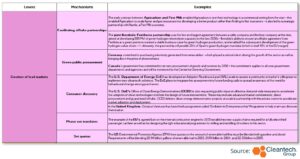Following a night of heavy rain, Dakar’s flooded roads were gridlocked on the morning of our recent cleantech policy consultation, hosted by Senegal’s Ministry of Environment. This did not deter anyone. Over two days of workshops, representatives from Senegal’s government, investor community, research, industry and NGOs discussed the state of Senegalese cleantech, and the most effective way for the government to support its growth. Although all participants were involved in Senegalese cleantech in some way, many were meeting for the first time.
Senegal is one of many countries setting ambitious goals to reduce greenhouse gas emissions and adapt to the effects of climate change. Cleantech innovation is playing, and will continue to play, a crucial role in achieving these goals, contributing to climate and economic resilience, future-proofing global human capital, and creating new economic opportunities for all.
Governments play an essential role in supporting innovative cleantech solutions. To make the most of finite resources, public support should be channelled where it can have the most impact. Moreover, policies which have worked in one part of the world need to be tailored to local contexts. By developing policy priorities in partnership with local cleantech ecosystem actors, governments can support more cleantech innovation to market, faster.
In partnership with UNIDO’s Global Cleantech Innovation Programme (GCIP), Cleantech Group has worked with ten countries across Africa, Eastern Europe, and Asia to define and shape the policies that will most effectively catalyze cleantech growth within their unique national contexts. Our Policy Toolkit comprises over 70 policy mechanisms which have been successfully deployed by leading cleantech ecosystems globally, and which countries can implement to further develop their own cleantech innovation.
Methodology of Cleantech Policy Intervention Toolkit
- Cleantech Group has developed a proprietary policy intervention toolkit comprised of 70+ mechanisms policy-makers can implement to support cleantech innovation
- These mechanisms have been identified through a two-year study including conversations with 80+ global cleantech ecosystem experts and thought leaders
- The policy mechanisms are divided into 4 areas:
- Early-Stage Innovation
- Demonstration and Commercialization
- Scaling and Internationalization
- Gender & Youth
- Each area has 4-5 levers which represent categories of instruments to shape policy
- Each lever has up to 10 mechanisms which are specific, real-world examples of tools government can use to accelerate cleantech innovation
Example of Cleantech Group’s Policy Intervention Toolkit

While every policy documented in the toolkit has been effective in boosting cleantech innovation somewhere, some interventions will be more useful in certain contexts than others, and some need to be adapted to local conditions.
Step 1: Evaluate Your Cleantech Ecosystem and Policy Maturity
Governments face resource constraints and must therefore define strategic cleantech priorities that deliver maximum impact.
For instance, cleantech deployment mandates can stimulate demand effectively if the technology is mature enough. If the technology is not yet ready to commercialize, however, such a mandate would only divert resources away from more impactful policy interventions, for example supporting technology de-risking.
Identifying the most impactful set of policies starts with understanding ecosystem maturity:
- Which start-ups currently exist and at what stage?
- Which policies have already been implemented and which are showing the best results?
- What are the biggest gaps experienced by local stakeholders?
Türkiye, for example, has a dynamic early stage cleantech ecosystem. It includes:
- Several cleantech clusters across the country
- Various government departments spearheading cleantech innovation
- Research, scientific and academic institutions driving cleantech skills, translating them into entrepreneurship, and promoting R&D
- VCs investing in early stage cleantech start-ups
- Ecosystem support organizations (ESOs)
- Corporates engaging with innovative start-ups
- International innovation partnerships
Between 2018 and 2023, Türkiye was home to 155 cleantech start-ups, and the ecosystem received around $138M in early-stage VC funding. For Türkiye, then, the priority is now supporting these early-stage start-ups to commercialize and scale their solutions.
In Cambodia, cleantech innovation is currently clustered in Phnom Penh. During the 2018-2023 period, the cleantech ecosystem included 32 start-ups which attracted approximately $10K early-stage VC funding. Of the 26 early-stage policy interventions in our Cleantech Group toolbox, only 7 were currently implemented in Cambodia when our work began. To ensure maximum impact on the Cambodian ecosystem, our work, therefore, prioritized policy interventions targeted at building a strong early-stage pipeline of innovative cleantech solutions.
Step 2: Identify What Works for Your Country
Policy recommendations should be both high impact and high feasibility, but this will look different for different countries. Many factors contribute to this, including domestic and geopolitical contexts, national budgets, cultural factors, and socio-economic indicators.
In Senegal, for example, we started our consultative policy work right after a presidential election and amidst the subsequent parliamentary elections. Stakeholders emphasized that the uncertainties associated with a changing political landscape were not conducive to major policy recommendations such as creating an entirely new cleantech innovation body. Instead, we focused on the window of opportunity afforded by a changing government, highlighting the economic and social opportunities that lie in expanding or strengthening existing cleantech innovation policy mechanisms. Better dissemination or publicizing of existing ecosystem support activities across the country was considered to have more potential impact in encouraging the creation of new cleantech start-ups outside the capital.
In Morocco, stakeholders viewed the introduction of phase-out mandates as a promising way to stimulate demand in their demonstration and commercialization-stage cleantech innovation ecosystem. However, some actors noted that previous attempts, including their 2015 plastic phase-out ban, had not achieved the intended success. With this in mind, emphasis was put on the need to design rigorous monitoring and control mechanisms to ensure effective enforcement.
In Türkiye, on the other hand, stakeholders deprioritized phase-out mandates entirely, opting instead for incentive-based policies – favoring “carrots” over “sticks.”
Priority Mechanisms: Creation of Lead Markets

Step 3: Bring Your Cleantech Ecosystem Together to Plan Next Steps
Identifying priority policy interventions is only the first piece of the puzzle. Creating or strengthening cleantech innovation ecosystems is as much about the people involved as it is about the tangible mechanisms implemented. Engaging, collaborating with, and securing buy-in from stakeholders are all key to its success. This includes pinpointing remaining challenges, identifying key decision-makers, establishing realistic timelines, and defining target results.
And perhaps the most impactful aspect, as we witnessed in Dakar, is simply bringing stakeholders together–sometimes for the very first time. This allows them to develop relationships they will continue to build upon, in turn fostering and strengthening a more sustainable and just future for their country.


